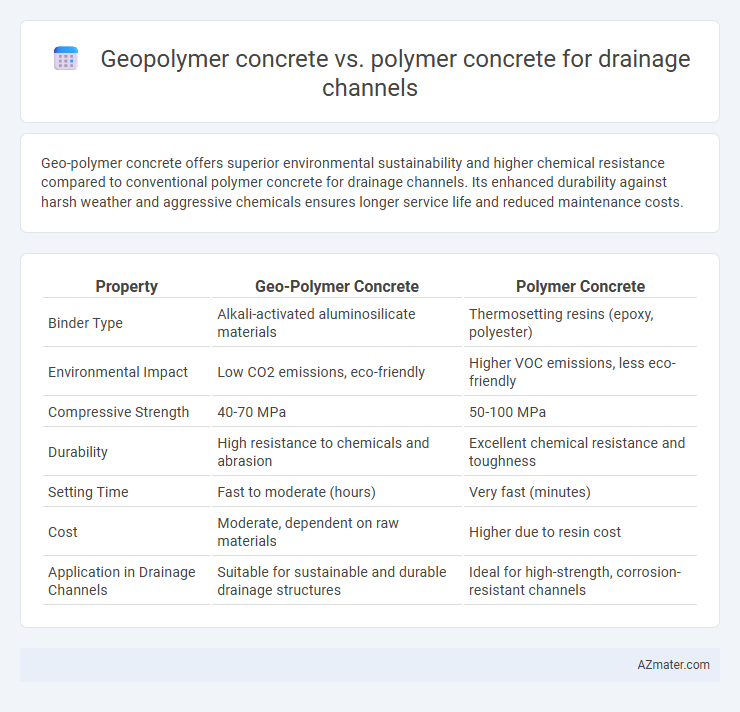Geo-polymer concrete offers superior environmental sustainability and higher chemical resistance compared to conventional polymer concrete for drainage channels. Its enhanced durability against harsh weather and aggressive chemicals ensures longer service life and reduced maintenance costs.
Table of Comparison
| Property | Geo-Polymer Concrete | Polymer Concrete |
|---|---|---|
| Binder Type | Alkali-activated aluminosilicate materials | Thermosetting resins (epoxy, polyester) |
| Environmental Impact | Low CO2 emissions, eco-friendly | Higher VOC emissions, less eco-friendly |
| Compressive Strength | 40-70 MPa | 50-100 MPa |
| Durability | High resistance to chemicals and abrasion | Excellent chemical resistance and toughness |
| Setting Time | Fast to moderate (hours) | Very fast (minutes) |
| Cost | Moderate, dependent on raw materials | Higher due to resin cost |
| Application in Drainage Channels | Suitable for sustainable and durable drainage structures | Ideal for high-strength, corrosion-resistant channels |
Introduction to Geo-Polymer and Polymer Concrete
Geo-polymer concrete is an eco-friendly building material synthesized from aluminosilicate-rich industrial byproducts like fly ash and slag, activated by alkaline solutions to form a durable binder. Polymer concrete consists of a polymer resin binder that replaces traditional cement, offering superior chemical resistance and rapid curing ideal for drainage channel applications. Both materials enhance durability and environmental sustainability compared to conventional concrete, with geo-polymer concrete emphasizing reduced carbon footprint and polymer concrete providing enhanced resistance to aggressive fluids.
Composition and Material Differences
Geopolymer concrete for drainage channels utilizes aluminosilicate materials such as fly ash or metakaolin activated by alkaline solutions, resulting in a cement-free binder with enhanced chemical resistance and sustainability benefits. Polymer concrete incorporates thermosetting resins like epoxy or polyester as a binder combined with aggregates, offering superior adhesion, rapid curing, and high durability against chemical attack. The primary difference lies in the binding matrix: geopolymer concrete relies on inorganic aluminosilicate chemistry, while polymer concrete depends on organic resin systems, influencing mechanical properties and environmental impact.
Manufacturing Processes
Geo-polymer concrete for drainage channels is produced using industrial by-products such as fly ash or slag activated with alkaline solutions, which significantly reduces carbon emissions compared to conventional cement-based concrete. Polymer concrete manufacturing involves mixing resins like epoxy or polyester with aggregates, curing quickly to achieve high chemical resistance and mechanical strength. The geo-polymer process emphasizes eco-friendly raw materials and longer curing times, while polymer concrete relies on synthetic binders that offer rapid setting and superior durability in corrosive environments.
Mechanical Properties Comparison
Geo-polymer concrete exhibits higher compressive strength and better chemical resistance than polymer concrete, making it more durable for drainage channel applications exposed to harsh environmental conditions. Polymer concrete offers superior tensile and flexural strength due to its polymer binder, providing enhanced crack resistance and flexibility under load. Both materials present distinct mechanical advantages, with geo-polymer concrete excelling in load-bearing capacity and polymer concrete offering improved toughness and elasticity.
Chemical Resistance and Durability
Geo-polymer concrete exhibits superior chemical resistance due to its aluminosilicate binder, which is highly resistant to acids and sulfates commonly found in drainage environments. Polymer concrete, while offering excellent resistance to solvents and hydrocarbons, can degrade under prolonged exposure to strong alkalis or ultraviolet light. The enhanced durability of geo-polymer concrete in aggressive chemical conditions makes it a preferred choice for long-term applications in drainage channel construction.
Environmental Impact and Sustainability
Geopolymer concrete for drainage channels significantly reduces carbon emissions by utilizing industrial by-products like fly ash and slag, offering a sustainable alternative to traditional Portland cement-based polymer concrete, which relies on petrochemical resins. Polymer concrete, though durable and resistant to chemical attack, involves higher embodied energy and generates non-biodegradable waste, impacting long-term environmental sustainability. Geopolymer concrete's lower lifecycle carbon footprint and enhanced recyclability make it a more eco-friendly choice for sustainable infrastructure development in drainage applications.
Cost Analysis and Economic Viability
Geo-polymer concrete offers significant cost advantages over traditional polymer concrete for drainage channels due to its use of industrial by-products like fly ash, reducing material expenses by up to 30%. The lower energy requirements in geo-polymer concrete production also contribute to decreased operational costs, enhancing its economic viability in large-scale infrastructure projects. Polymer concrete, while providing high chemical resistance, generally incurs higher raw material and production costs, making geo-polymer concrete a more cost-effective and sustainable choice for drainage channel applications.
Performance in Drainage Channel Applications
Geo-polymer concrete offers superior chemical resistance and durability in drainage channel applications compared to polymer concrete, which can degrade under prolonged exposure to aggressive wastewater. The high compressive strength and low permeability of geo-polymer concrete enhance its performance by preventing water infiltration and minimizing structural damage over time. Its sustainable composition also reduces maintenance costs, making it a more efficient choice for long-term drainage infrastructure.
Installation and Maintenance Requirements
Geo-polymer concrete offers faster installation for drainage channels due to its rapid setting time and reduced curing requirements, enhancing project efficiency in wet environments. Polymer concrete requires careful handling during installation to ensure adequate bonding and chemical resistance, which can extend preparation time. Maintenance of geo-polymer concrete is generally lower because of its superior chemical and abrasion resistance, while polymer concrete demands periodic inspections to address potential surface wear and UV degradation.
Conclusion: Which is Better for Drainage Channels?
Geopolymer concrete offers superior durability, chemical resistance, and environmental sustainability compared to polymer concrete, making it more suitable for drainage channels exposed to harsh weather and aggressive chemicals. Polymer concrete provides excellent mechanical strength and faster curing times but lacks the long-term sustainability and high resistance to sulfate and acid attack found in geopolymer alternatives. For drainage channels requiring minimal maintenance and longer service life, geopolymer concrete is the better choice due to its enhanced performance in corrosive environments and reduced carbon footprint.

Infographic: Geo-polymer concrete vs Polymer concrete for Drainage channel
 azmater.com
azmater.com